2015: How low can it go?
By Colin Twiggs
January 15th, 2015 12:30 a:m ET (4:30 p.m. AEDT)
Advice contained herein is provided for the general information of readers and does not have regard to any particular person's investment objectives, financial situation or needs. Accordingly, no reader should act on the basis of any information herein without first having consulted a suitably qualified financial advisor.
Financial markets have endured a fair degree of turbulence in the last 6 months and made a faltering start to the new calendar year. Is this a sign of an imminent collapse or will markets recover to post further gains in 2015? Key determinants will be falling oil prices and the impact of monetary policy in the big four economies: the US, EU, China and Japan.
Crude Oil: How low can it go?
Crude oil is plunging towards its 2008 low of $30 per barrel. Supply is inelastic, with the Saudis refusing to play their normal role as swing producer and cut production to stabilize prices. Demand will take time to recover despite the massive stimulus effect of low oil prices to the global economy. If current supply levels continue, the 2008 bottom is under threat.
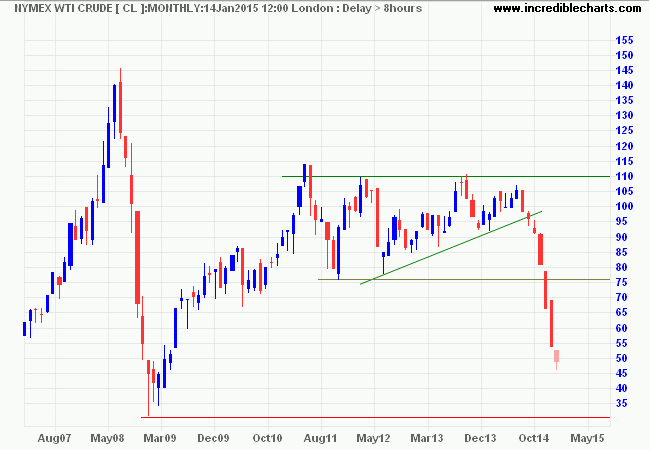
More likely than a cut in demand, is a threat to supply, with political turmoil erupting in one or more of the countries reliant on oil revenue: Russia, Iran, Venezuela, Nigeria, Iraq, Libya and other vulnerable states. Political turmoil could be a reaction to food scarcity and rising prices, as Venezuelans are already experiencing, or it could be fomented by one/more vulnerable producers seeking to throttle supply and drive up prices. Apart from domestic instability, sovereign default by Russia, while still unlikely, could also unsettle financial markets.
How will falling oil prices affect the global economy?
Energy stocks are falling, increasing downward pressure on broad market indices.
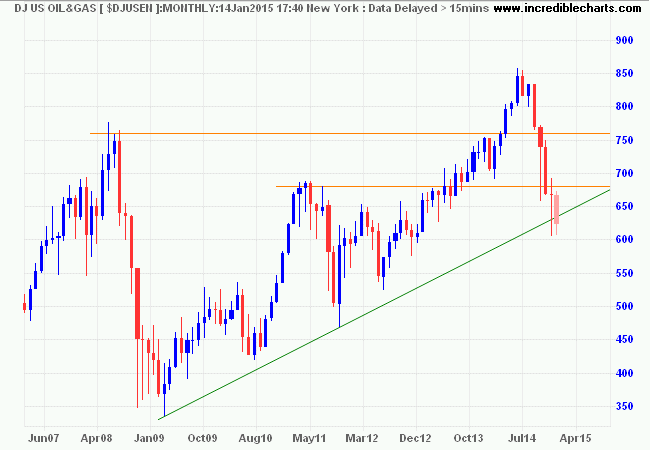
Inflation expectations are falling, with the spread between 5-year Treasury yields and the equivalent inflation-adjusted TIPS well below the Fed's 2 percent inflation target.
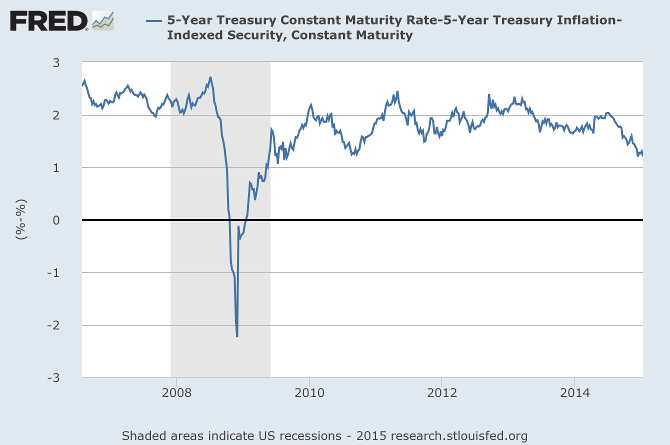
Will falling oil prices increase the risk of deflation, as suggested by some pundits? Highly unlikely. Falling prices may shift consumer spending patterns, with consumers spending the savings from lower energy prices on other discretionary items. But this is likely to boost confidence and encourage further spending, rather than cause a contraction of total spending.
Falling prices caused by a contraction in total spending, as in 2008/2009, are an entirely different matter. Consumers increased savings and repaid debt in response to rising uncertainty. Prices fell in response to the resulting contraction in spending. Shrinking aggregate demand impacted on incomes, causing further cuts in spending and a self-reinforcing, deflationary spiral which caused serious damage to the economy despite the Fed's best efforts.
Current price falls are driven by increasing supply, while a deflationary spiral is caused by contracting aggregate demand. Lower oil prices will act as a huge stimulus for the global economy towards the second half of the year and are likely to lift growth rates.
US stocks
Low inflation is likely to ease pressure on the Fed to lift interest rates. The S&P 500 continues in a bull-trend, with 13-week Twiggs Money Flow trending above zero, indicating long-term buying pressure. Respect of support at 2000 would suggest another advance and breakout above 2100 would confirm.
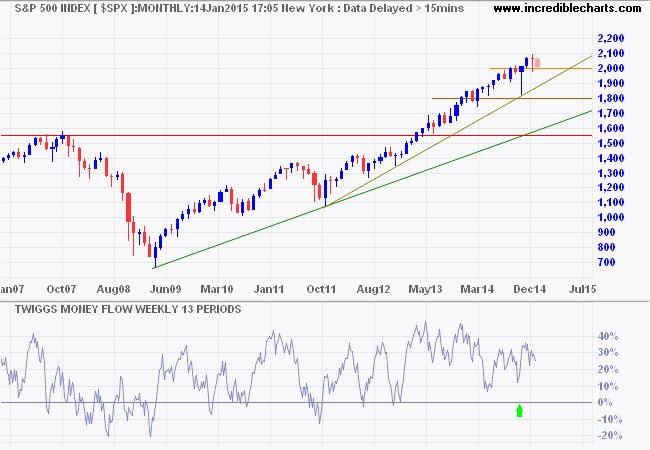
* Target calculation: 2000 + ( 2000 - 1800 ) = 2200
Rising troughs on CBOE Volatility Index (VIX) indicate a shift from low to moderate risk, but there is no cause for concern unless we see activity ranging between 20 and 30.
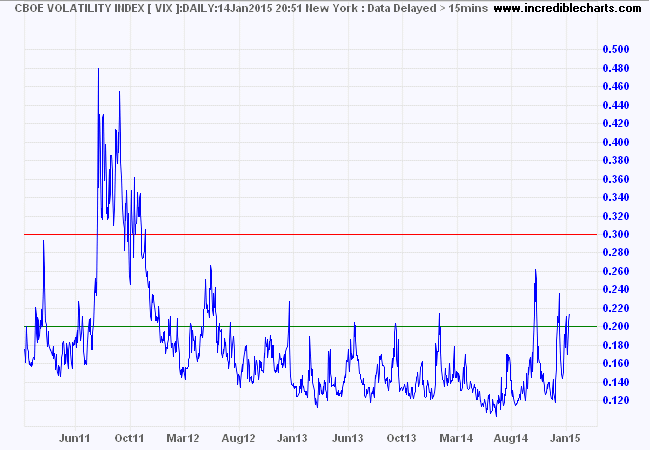
Europe
The graph below compares the annual rate of change in total assets of the European Central Bank (ECB) to the Fed. Fed assets are stated net of excess reserve deposits which pay interest to depositing banks, something not offered by the ECB. Both the Fed and ECB rapidly expanded their balance sheets in 2008 in response to the global financial crisis, while the ECB had to repeat the process in 2011/2012 to address the PIIGS sovereign debt crisis. The ECB's mistake was allowing their balance sheet to shrink in 2013, in response to pressure from some members (primarily Germany) to return to austerity. The Fed was far more wary of aftershocks and maintained an expansionary policy throughout this period. The US economy strengthened as a result, while the EU contracted and threatens a deflationary spiral if the ECB does not alter course.
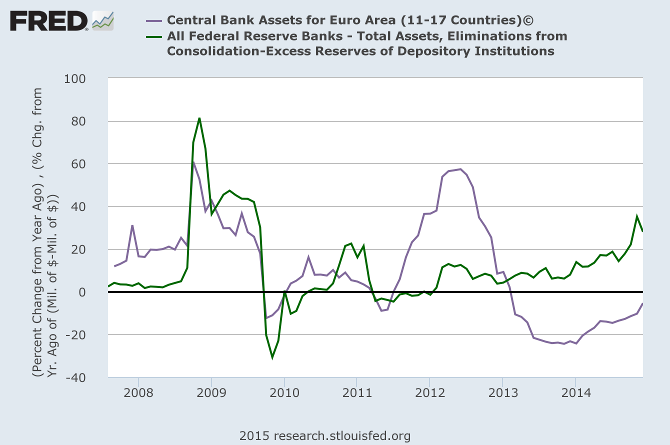
Dow Jones Euro Stoxx 50 proved surprisingly resilient in the circumstances, breaking above 3000. Expect further consolidation between 3000 and 3300 until we get a clear direction from the ECB. Declining 13-Week Twiggs Momentum is typical of a long-term consolidation. But reversal below 3000 would warn of a contraction.
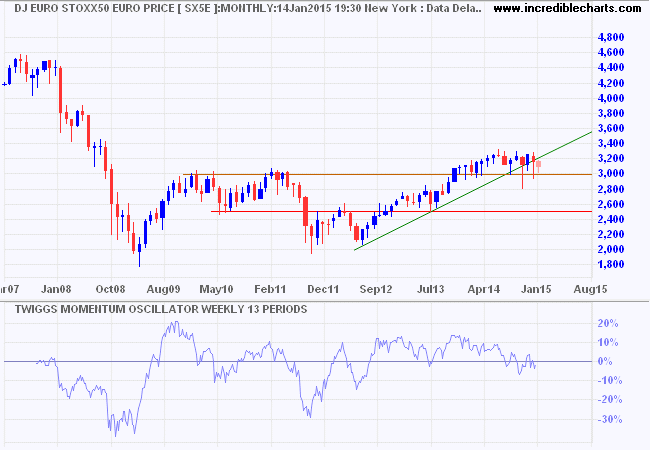
China
The PBOC is also adopting expansionary monetary policy in response to declining activity and a weakening Yen (which erodes China's export advantage). The Shanghai Composite Index surged, with 13-week Twiggs Money Flow indicating strong buying pressure. Breakout above 3400/3500 would suggest another up-trend.
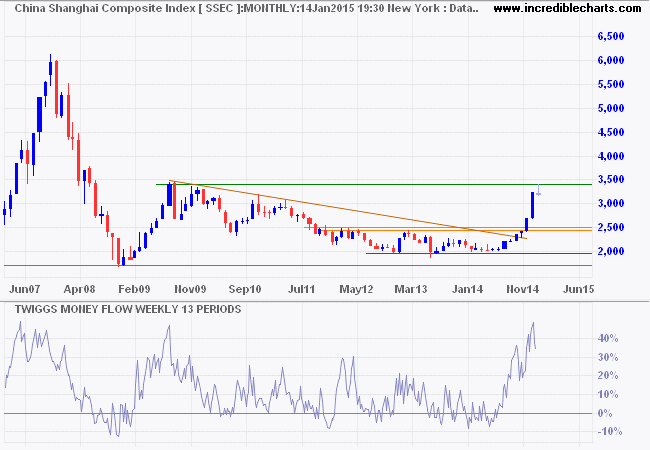
Japan
We have a similar situation in Japan, with the BOJ expanding on a massive scale, driving stocks higher and the Yen lower. The Nikkei 225 found resistance at its 2007 high of 18000, but Twiggs Money Flow appears strong and the index is likely to respect support at 16000.
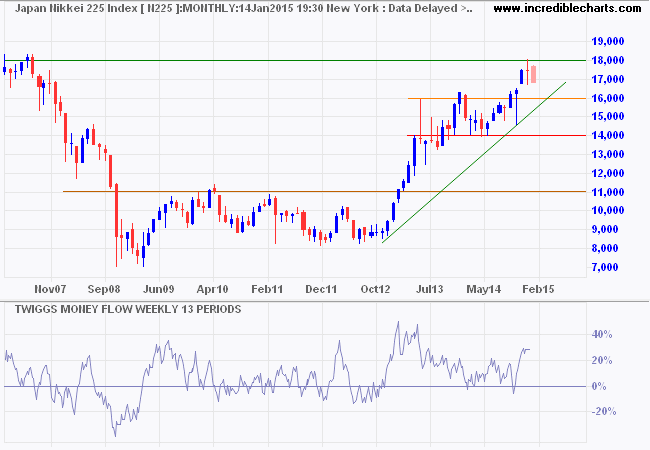
Aggressive monetary policy adopted by the two central banks is high risk and could end in tears. Especially if the two start to compete in currency markets for an export advantage.
Australia
The RBA is far more conservative and likely to rely on falling commodity prices to weaken the Australian Dollar. Further interest rate cuts seem unlikely given the current scenario. The ASX 200 has not made any progress since July last year, but rising troughs on 13-week Twiggs Money Flow indicate healthy support at 5000. Breakout above 5500 is unlikely at present, but would suggest another advance.
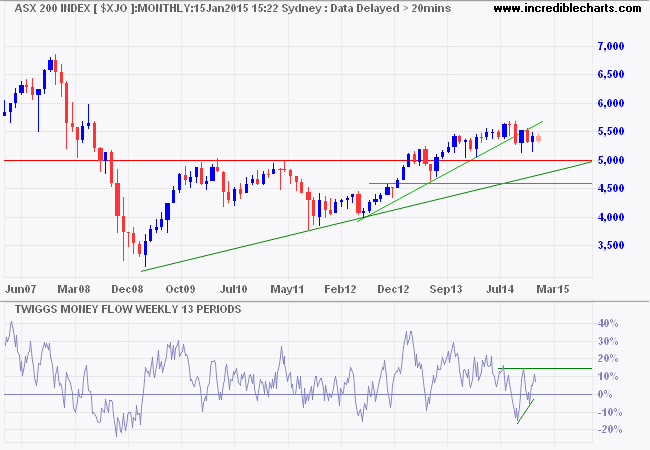
Low iron ore, coal and LNG gas prices are likely to inhibit the Australian recovery. What is needed is a strong program of infrastructure investment to restore confidence. This seems to be slow in getting off the ground. What is important is investment in productive assets, that produce market related returns on investment, rather than social infrastructure. The acid test is whether the completed assets can be sold to recoup money invested, providing funding for further infrastructure assets or to repay debt.
The only value of stock forecasters is to make fortune-tellers look good.
~ Warren Buffett
Disclaimer
Research & Investment Pty Ltd is a Corporate Authorized Representative (AR Number 384 397) of Andika Pty Ltd which holds an Australian Financial Services Licence (AFSL 297069).
The information on this web site and in the newsletters is general in nature and does not consider your personal circumstances. Please contact your professional financial adviser for advice tailored to your needs.
Research & Investment Pty Ltd ("R&I") has made every effort to ensure the reliability of the views and recommendations expressed in the reports published on its websites and newsletters. Our research is based upon information known to us or which was obtained from sources which we believe to be reliable and accurate.
No guarantee as to the capital value of investments, nor future returns are made by R&I. Neither R&I nor its employees make any representation, warranty or guarantee that the information provided is complete, accurate, current or reliable.
You are under no obligation to use these services and should always compare financial services/products to find one which best meets your personal objectives, financial situation or needs.
To the extent permitted by law, R&I and its employees, agents and authorised representatives exclude all liability for any loss or damage (including indirect, special or consequential loss or damage) arising from the use of, or reliance on, any information. If the law prohibits the exclusion of such liability, such liability shall be limited, to the extent permitted by law, to the resupply of the said information or the cost of the said resupply.
Important Warning About Simulated Results
Research & Investment (R&I) specialise in developing, testing and researching investment strategies and systems. Within the R&I web site and newsletters, you will find information about investment strategies and their performance. It is important that you understand that results from R&I research are simulated and not actual results.
No representation is made that any investor will or is likely to achieve profits or losses similar to those shown.
Simulated performance results are generally prepared with the benefit of hindsight and do not involve financial risk. No modeling can completely account for the impact of financial risk in actual investment. Account size, brokerage and slippage may also diverge from simulated results. Numerous other factors related to the markets in general or to the implementation of any specific investment system cannot be fully accounted for in the preparation of simulated performance results and may adversely affect actual investment results.
To the extent permitted by law, R&I and its employees, agents and authorised representatives exclude all liability for any loss or damage (including indirect, special or consequential loss or damage) arising from the use of, or reliance on, any information offered by R&I whether or not caused by any negligent act or omission.

Author: Colin Twiggs is a former investment banker with almost 40 years of experience in financial markets. He co-founded Incredible Charts and writes the popular Trading Diary and Patient Investor newsletters.
Using a top-down approach, Colin identifies key macro trends in the global economy before evaluating selected opportunities using a combination of fundamental and technical analysis.
Focusing on interest rates and financial market liquidity as primary drivers of the economic cycle, he warned of the 2008/2009 and 2020 bear markets well ahead of actual events.
He founded PVT Capital (AFSL No. 546090) in May 2023, which offers investment strategy and advice to wholesale clients.
